VOLUME OF FISHERIES PRODUCTION IN DAVAO DE ORO
The total fisheries production in the province of Davao de Oro in 2021 was recorded at 1,669.54 metric tons from 1,431.91 metric tons output in 2020, representing an annual increase of 16.60 percent. This was brought about by the increase in production from marine municipal fisheries and aquaculture. Only inland municipal registered a downtrend in production during the period. (see Table A)
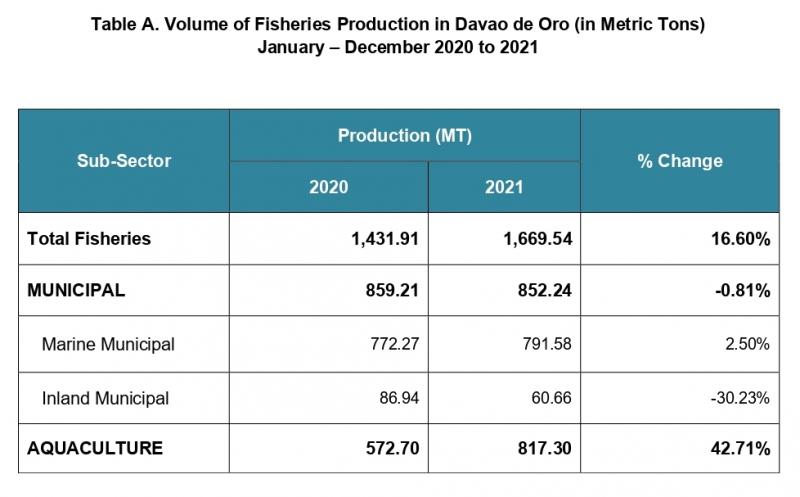
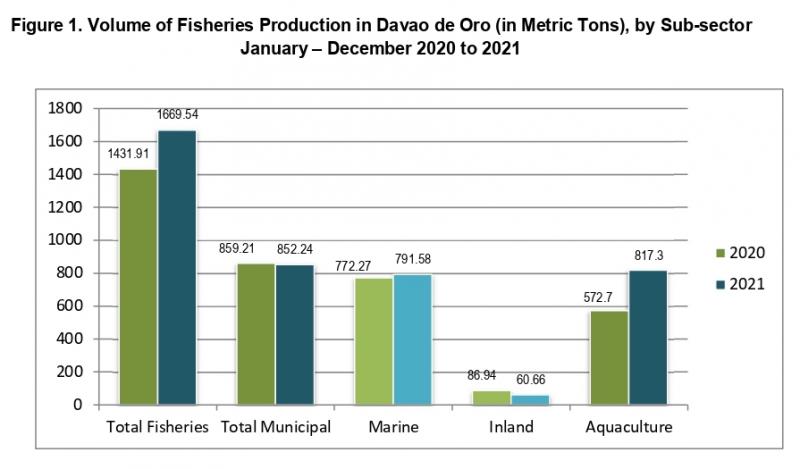
The volume of fish production is contributed by three sub-sectors composed of commercial, municipal, and aquaculture. However, commercial fisheries are not applicable in Davao de Oro as the province has no commercial fishing operations.
In 2021, aquaculture accounted for 49% of the total volume, while municipal, which contains marine and inland fishing, contributed 50%; 47% of this volume was attributed to marine municipal, whereas 4% came from inland fishing.
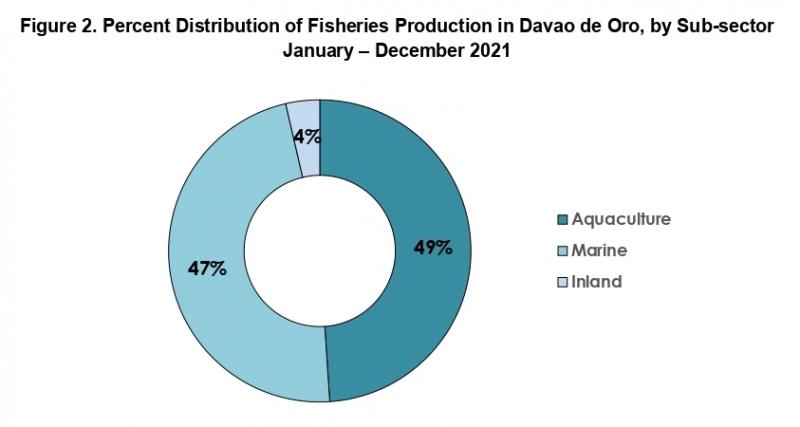
MUNICIPAL FISHERIES PRODUCTION
The volume of production of municipal fisheries in Davao de Oro is comprised of marine municipal and inland municipal productions. In the year 2021, the total volume of production summed up to 852.24 metric tons. It decreases by -0.81 percent compared to 2020, with a production of 859.21 metric tons.
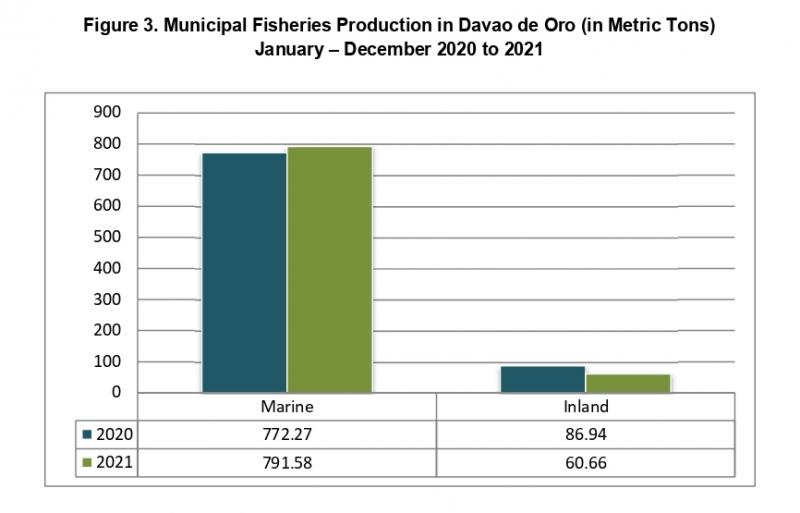
In the Quarterly Fisheries Survey in 2021, Davao de Oro's marine municipal production grew 2.50 percent over the year 2020. From 772.27 metric tons in 2020, it increased to 791.58 metric tons in 2021. While marine municipal production grew positively in 2021, inland municipal production fell by -30.23 percent, dropping from 86.94 metric tons in 2020 to only 60.66 metric tons.

The top three species with the highest number of catches in marine municipal for the year 2021 are the following: Bali Sardinella, Big-eyed scad, and Indian mackerel. As shown in Table B, Bali Sardinella has the highest catch among other species with a production of 73.61 metric tons, which also shows a positive growth of 4.37 percent compared to last year which has a catch of 70.53 metric tons. Second in production is Big-eyed scad which posted a negative growth of -9.42 percent, from 52.84 metric tons in 2020 to 47.86 metric this 2021. Lastly is the Indian mackerel, which is the third species with the highest catch this quarter by 46.36 metric tons but also shows a negative growth compared to its production of 51.00 metric tons last year.
AQUACULTURE FISHERIES PRODUCTION
The volume of production on Aquaculture fisheries in Davao de Oro posted a positive growth of 42.71 percent in 2021. From 572.70 metric tons recorded in the year 2020, it increased to 817.30 metric tons in 2021.
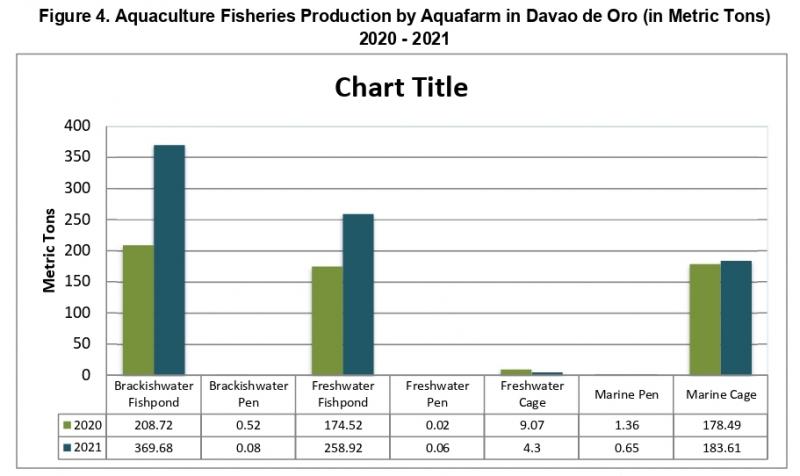
In the aquaculture sector, brackishwater fishponds, freshwater fishponds, freshwater pens, and marine cages recorded positive production growth as compared to last year. This year, brackishwater fishpond production increased by 77.12 percent from 208.72 metric tons to 369.68 metric tons, while freshwater fishpond production increased by 48.36 percent from 174.52 metric tons to 258.91 metric tons. Likewise, freshwater pens increased by 200 percent from 0.02 to 0.06 metric tons; in the same year, marine cages increased by 2.87 percent, from 178.49 to 183.61 metric tons. There was, however, negative growth in the production of brackishwater pens by -84.62 percent, from 0.52 metric tons in 2020 to 0.08 metric tons this year, along with freshwater cages by -52.59 percent, from 9.07 metric tons to 4.30 metric tons this year, and marine pens by -52.21 percent, from 1.36 metric tons to 0.65 metric tons in 2021. (see Figure 4 and Table C)
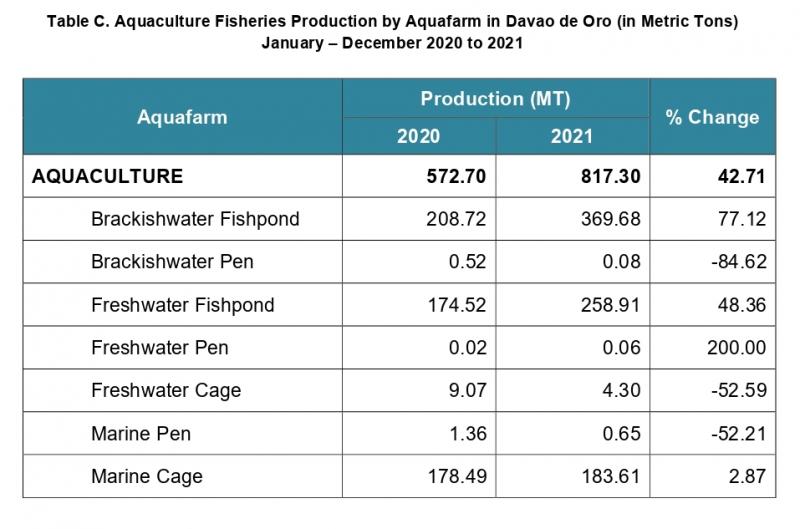
Technical Notes:
Commercial fishing – is the catching of fish with the use of fishing boats with a capacity of more than three gross tons for trade, business, or profit beyond subsistence or sports fishing.
Municipal Fishing - covers fishing operations carried out with or without the use of a boat weighing three gross tons or less.
Inland Municipal Fishing - the catching of fish, crustaceans, mollusks, and all other aquatic animals and plants in inland water like lakes, rivers, dams, marshes, etc. using simple gears and fishing boats some of which are non-motorized with a capacity of three gross tons or less; or fishing not requiring the use of fishing boats.
Aquaculture - fishery operation involving all forms of raising and culturing of fish and other fishery species in marine, brackish and freshwater environments. Examples are fishponds, fish pens, fish cages, mussels, oysters, seaweed farms, and hatcheries.
Aquafarm - the farming facilities used in the culture or propagation of aquatic species including fish, mollusk, crustaceans, and aquatic plants for purposes of rearing to enhance production.
Brackish water – is a mixture of seawater and freshwater with salinity that varies with the tide. Examples are estuaries, mangroves, and mouths of rivers where seawater enters during high tide.
Fisheries - all activities relating to the act or business of fishing, culturing, preserving, processing, marketing, developing, conserving, and managing aquatic resources and the fishery areas including the privilege to fish or take aquatic resources thereof (RA 8550).
Fisheries Sector - the sector engaged in the production, growing, harvesting, processing, marketing, developing, conserving, and managing of aquatic resources and fishery areas.
Fish Cage - stationary or floating fish enclosure made of synthetic net wire/bamboo screen or other materials set in the form of an inverted mosquito net ("happy" type) with or without cover with all sides either tied to poles stacked to the water bottom or with anchored floats for aquaculture purposes.
Fishing Gear - any instrument or device and its accessories utilized in taking fish and other fishery species.
Fishing Grounds - areas in any body of water where fish and other aquatic resources congregate and become the targets of capture.
Fish Pen - an artificial enclosure constructed within a body of water for culturing fish and fishery/ aquatic resources made up of bamboo poles closely arranged in an enclosure with wooden materials, screen, or nylon netting to prevent the escape of fish.
Fishpond - a body of water (artificial or natural) where fish and other aquatic products are cultured, raised, or cultivated under controlled conditions. This island-based type of aquafarm. Note that the setting-up of fish cages in ponds does not make the operation of the fish cage and at the same time a fishpond.
Freshwater – is water without salt or marine origins, such as generally found in lakes, rivers, canals, dams, reservoirs, paddy fields, and swamps.
Landing Center – a place where the fish catch and other aquatic products are unloaded and traded.
